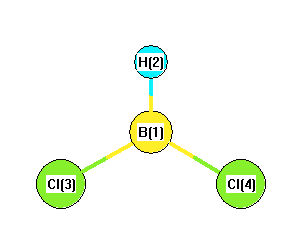Geometric Data

Point Group C2v
Internal coordinates
distances (r) in Å, angles (a) in degrees, dihedrals (d) in degrees
These cartesians were determined using some assumed coordinate values.
Cartesians
| Atom |
x (Å) |
y (Å) |
z (Å) |
| B1 |
0.0000 |
0.0000 |
0.7189 |
| H2 |
0.0000 |
0.0000 |
1.8489 |
| Cl3 |
0.0000 |
1.5132 |
-0.1601 |
| Cl4 |
0.0000 |
-1.5132 |
-0.1601 |
Atom - Atom Distances 
Distances in Å
| |
B1 |
H2 |
Cl3 |
Cl4 |
| B1 |
|
1.1300 | 1.7500 | 1.7500 |
| H2 |
1.1300 |
|
2.5151 | 2.5151 |
| Cl3 |
1.7500 | 2.5151 |
|
3.0265 |
| Cl4 |
1.7500 | 2.5151 | 3.0265 |
|
Calculated geometries
for BHCl
2 (Borane, dichloro-).
Experimental Bond Angles (degrees) from cartesians 
| atom1 |
atom2 |
atom3 |
angle |
|
atom1 |
atom2 |
atom3 |
angle |
| H2 |
B1 |
Cl3 |
120.150 |
|
H2 |
B1 |
Cl4 |
120.150 |
| Cl3 |
B1 |
Cl4 |
119.700 |
Bond descriptions
Examples: C-C single bond, C=C, double bond, C#C triple bond, C:C aromatic bond
| Bond Type |
Count |
| H-B |
1 |
| B-Cl |
2 |
Connectivity
| Atom 1 |
Atom 2 |
| B1 |
H2 |
| B1 |
Cl3 |
| B1 |
Cl4 |











